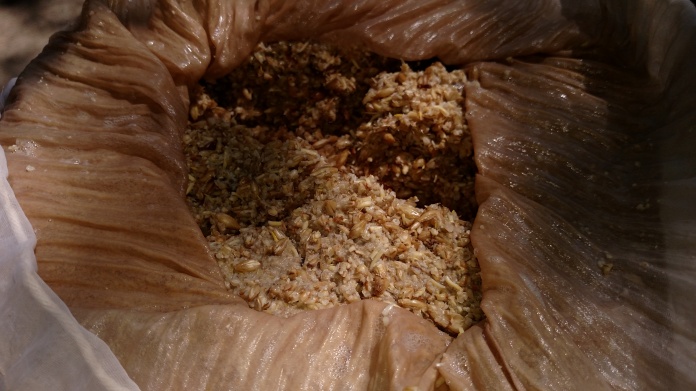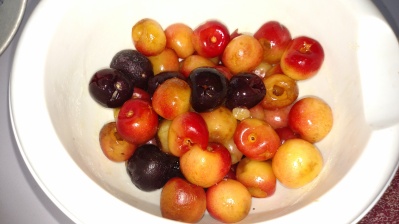
The set-up. Mashing in and maintaining temp with a blanket and a “space blanket”.
It took awhile to get organized this morning, but eventually, I got started. I began with 6.25 gallons of strike water heated to 149F…but it overshot a little. After I added the grains, the water came down to 150.8, but that’s okay. The mash went for 60 minutes. I checked it at 30 minutes and it was still 150.6F.
Next, I raised the temperature to 170F and did a mash-out for a few minutes and then did my usual rigged sparge with 2 gallons of water at 170F.

My McGyver sparge set-up.
That put my boil at about 7 gallons. The pre-boil specific gravity reading was 1.035…a little lower that expected. Looking at my grain, I don’t think the brew shop double-milled the grain for “brew in a bag” (BIAB), as I requested and it looks like my efficiency is suffering for it.

After the sparge…looks like a pretty coarse crush.
I’m not really hung up on the ABV, though. It’s supposed to be a “lawn mower” style beer anyway; this the name. If you aren’t familiar with the term, it means a beer suitable for after mowing the lawn. Lighter body, lower alcohol, refreshing. Plus this one has Mt. Ranier Cherries (I had to add a few regular ones to make up a pound), stems removed, pitted.

Mostly Mt Ranier cherries, stemmed and pitted.
When I move it to secondary fermentation, I’ll be adding about a pound (minus a couple samples!) of dried Mt Ranier cherries. Have to make sure to get ones NOT processed with sunflower, or any other, oil.
So, after the sparge, I started the boil. I did remove about a gallon of wort to reduce the chance of boil-over. Once the boil was going, I added the first 1/2 oz of Citra hops. After 15 minutes, I added back the excess wort. I did get one small boil-over, but I reacted quickly and didn’t really lose much at all. After 45 minutes, I added the next 1/2 oz of Citra hops and 1 teaspoon of Irish Moss (to facilitate clearing). At 55 minutes, I added another 1/2 oz of Citra hops (the last hops addition will be a dry hop in secondary). At 3 minutes, I added the cherries.

Just about done with the boil.
Then it was time to use the wort chiller. Unfortunately, with the temps in the mid nineties daily, the water temp coming from the hose is 80F+. I was only able to get the wort down to about 84F. So, I brought the wort inside and transferred it to a carboy. Unfortunately, again, it’s difficult to transfer from a stock pot to a carboy…especially with cherries in the wort! I did sanitize everything, but I’m keeping my fingers crossed that there was no contamination. I used a stainless steel Kitchenaid mixing bowl and a rigged paper cup funnel to dip and pour the wort into the carboy. I could really use a brew kettle with a valve/spout. I wound up with about 5-1/2 gallons of wort in the carboy and about 3/4 gallon in a separate, small fermentation bucket. I think I’ll use the extra for a blackberry experiment.
I let the wort sit for awhile to cool a little more and then added the US-05 yeast. I sprinkled enough on the small batch to cover the top and the rest went into the carboy. I’m afraid the temp was still around 80-81F…thought I killed the yeast. But, the yeast survived! The next morning, there was good action going on.

It’s alive! It’s alive!
There is a possibility, at the higher temperatures, that some “fruity esters” will develop. They’re considered undesirable in most beers, but in a fruit beer, may be okay. If they do develop…meh. Maybe they’ll compliment the cherries. I’m not sure I would pick them out, anyway. Oh, and after I finished and cleaned everything up, I made two batches of spent grain dog treats. That should last awhile…it’s over 3 pounds. The rest of the used grain is feeding my compost bin.

Spent grain.

Spent grain doggie treat dough, patted out and cut…ready for oven.

Four bags of doggie treats, about 12 to 13 ounces each.
















